Mirage as an optical phenomenon. Mirage - what is it? The meaning of the word "mirage"
Mirages as an atmospheric phenomenon in nature
Mirages (from the French “mirage”) are optical phenomenon in the atmosphere, due to which images of objects appear in the visibility zone that under normal conditions are hidden from observation. This kind of miracles happen because in an optically inhomogeneous atmosphere, rays of light are bent, as if looking beyond the horizon. Most often, inhomogeneities arise due to uneven heating of air at different altitudes. In Ancient Egypt they believed that a mirage was the ghost of a country that no longer exists. Legend says that every place on our planet has its own soul.
More often, mirages can be observed in the desert. This can be explained by the fact that hot air acts like a mirror. For example, in the Sahara, about 160,000 mirages are observed every year; they can be stable and wandering, vertical and horizontal.
Caravans in the Erg-er-Ravi desert in North Africa are especially often victims of mirages. People see oases “with their own eyes” at a distance of 2–3 km, which are actually no less than 700 km away. A mirage can mislead even experienced people.
Thus, 360 km from the Bir-Ula oasis, a caravan led by an experienced guide from local tribes fell victim to a mirage. 60 people and 90 camels died as they followed the deceptive mirage, which carried them 60 km away from the well.
In ancient times, nomads lit a fire to make sure whether they were seeing a mirage or real objects. If there was even a slight movement of air in the desert, then the smoke spreading along the ground quickly dispersed the mirage. Maps have been compiled for many caravan routes, which indicate the places of frequently encountered mirages. These maps even indicate where wells, oases, palm groves, mountain ranges, etc. are visible.
Atmospheric mirages are divided into three classes, and the reasons that cause them are quite diverse.
Mirages of the first class are the so-called lake, or lower, mirages. They are the most common and simple. For example, water seen on desert sand or hot asphalt is a mirage of the sky above the hot sand or asphalt. Airplane landings in films or car races on television are often filmed quite close to the surface of hot asphalt. Then below the car or plane you can see their mirror image (inferior mirage), as well as the mirage of the sky.
The higher you are on land or in the sea, the less dense the air. Under normal conditions, air density decreases with increasing altitude. When light passes over the surface of the earth, the air below the light beam is denser than above. A typical property of light is that it refracts toward a denser medium, and thus a ray that travels across the surface of the earth is actually always slightly refracted downward and travels along the slightly curved surface of the earth instead of heading straight toward the sky.
The denser air seems to slow down the lower end of the beam and pull it towards itself. On the other hand, a person imagines that an object is in the direction from which the light reaches his eyes. Thus, when you look at the distant horizon, you see objects that are actually partially below the horizon. The light from these objects is refracted along the curved surface of the earth or sea and therefore it only seems that the light reaches the observer's eye from the horizon.
Many are familiar with the phrase that states that when we look at the sun as it sets, it is actually already below the horizon. In astronomy, this phenomenon is known as refraction: the refraction of light in the atmosphere raises celestial bodies on the horizon at approximately half a degree of angle.
Very often, air density does not change uniformly with altitude, and cold, denser air and warm air form layers of different temperatures at different altitudes. The movement of light in such air can be quite erratic, thus creating a distorted image of the landscape.
The inferior mirage is identical in structure: there is always only one inverted, more or less flattened mirage below the object. If the landscape itself is beautiful, then its mirage is also beautiful, and together they can spread across the horizon in a string of buildings and treetops.
If this happens in a desert, the surface of which and the adjacent layers of air are heated by the sun, the air pressure at the top can be high, the rays will begin to bend in the other direction. And then interesting phenomena will begin to occur with those rays that should have been reflected from the object and immediately hit the ground. But no, they will turn upward and, having passed perigee somewhere near the surface itself, will go into it.
Let us now imagine that such a beam, already bent, hits the pupil of a traveler walking through the desert. But to subjective perception, the object (say, a palm tree) will be located in the place where the tangent to the ray path points. Accordingly, the image of the palm tree will be reversed, as if reflected in the water. And a lot of water will spill around. Such an insidious joke will be played on the thirsty traveler by the sky moving to the sands.
French scientist Gaspard Monge, who took part in Napoleon’s Egyptian campaign, described his impressions of the lake mirage as follows: “When earth's surface strongly heated by the Sun and just beginning to cool down before the onset of twilight, the familiar terrain no longer extends to the horizon as during the day, but turns, as it seems, at about one league into a continuous flood.
The villages further away look like islands in a lost lake. Under each village there is an overturned image of her, only it is not sharp, small details are not visible, like a reflection in water, swayed by the wind. If you begin to approach a village that seems to be surrounded by a flood, the shore of the imaginary water moves away, the water arm that separated us from the village gradually narrows until it disappears completely, and the lake now begins behind this village, reflecting the villages located further away.
The lower mirage can be observed by anyone. If you stand on a railway track or a hill above it on a hot summer day, when the sun is slightly to the side or to the side and slightly in front of the railway track, you can see how the rails 2-3 km ahead seem to be plunging into a sparkling lake - as if the tracks were flooded. If we try to get closer to the “lake”, it will move away, and no matter how much we walk towards it, it will invariably be at the same deceptive distance.
Mirages of the second class - the rays of which bend beyond the horizon line, are called upper, or distant vision mirages. They appear right in the sky. If warm air, heated somewhere above the desert, invades the upper layers of the atmosphere, and below there is cold dense air of an anticyclone, then the rays that have undergone refraction can look very deeply beyond the horizon. Light reflected from a distant object (for example, an island) finds two paths to the observer's eyes: the first passes almost straight from the island to the observer, and the second rises slightly upward to the warm air layer, where the beam is refracted downward at a slight angle to the colder air and reaches the eye of the observer from above.
Two images of the same island are created - one normal, and the second an inverted image above the island, i.e. a superior mirage. In turn, the specific type of atmospheric phenomenon that creates such a mirage is called a thermal inversion. Then on the surface of the cold air mass lies a clearly defined, lighter and less dense layer of warm air. Severe thermal inversion also causes random interference on radios, television reception, and cell phones.
2006, May 8 - thousands of tourists and local residents observed a mirage that lasted for 4 hours in the city of Penglai near east coast China on Sunday. The fogs created an image of a city with modern high-rise buildings, wide city streets and noisy cars. It rained in Penglai for 2 days before this rare weather event occurred. Residents Cote d'Azur France on a clear morning has been seen more than once on the horizon Mediterranean Sea, where the water merges with the sky, a chain of Corsican mountains rises from the sea, about 200 km from the Cote d'Azur.
The superior mirage is described in one of the works of N.V. Gogol:
“A great miracle appeared behind Kyiv! Suddenly it became visible far to all corners of the world. In the distance the Liman turned blue, and beyond the Liman the Black Sea overflowed. Experienced people recognized both the Crimea, which rose like a mountain from the sea, and the marshy Sivash. On the right hand the land of Galicia was visible.
What is it? - the assembled people interrogated, pointing to the gray and white tops that seemed far away in the sky and looked more like clouds.
That Carpathian mountains! - the old people said.”
Lateral mirages can occur in cases where layers of air of the same density are located in the atmosphere not horizontally, as usual, but obliquely or even vertically. Similar conditions are created in the summer, in the morning shortly after sunrise on the rocky shores of the sea or lake, when the shore is already illuminated by the sun, and the surface of the water and the air above it are still cold. Lateral mirages have been repeatedly observed on Lake Geneva. For example, people saw a boat that was approaching the shore, and next to it exactly the same boat was moving away from the shore. A side mirage can appear near a stone wall of a house heated by the sun, and even on the side of a heated stove.
Thanks to a side mirage, silent, foggy ghosts appear, blocking the traveler’s path in the mountains. Usually, a frightened person sees himself. Strongly heated rocks cause such air rarefaction around them that the rays reflected from the observer and directed towards the rocks are bent near them to such an extent that, like a boomerang, they return back.
Images in side mirages are almost always equal in size to reflected objects, but they can double, triple, etc. There is a hypothesis that the famous ghosts that have taken a fancy to some castles are nothing more than a side mirage. In winter, as you know, dank, damp walls need to be intensively heated. The stones that make up the ovens are much hotter than boulders in the midday sun, and the high vaulted ceilings allow the beam to loop around and return to the observer.
Third class mirages are amazing mirages called ultra-long-range vision mirages. For them, distances of thousands of kilometers are not a hindrance. This is the case described in the book “Optical Phenomena in Nature”:
“On the night of March 27, 1898, among Pacific Ocean The crew of the Bremen ship "Matador" was frightened by the vision. Around midnight, the crew spotted a ship about two miles away that was battling a strong storm. This was all the more surprising because there was calm all around. The ship crossed the course of the Matador, and there were moments when it seemed that a collision between the ships could not be avoided...
The crew of the Matador saw how, during one strong wave impact on an unknown ship, the light in the captain’s cabin, which was visible all the time in two portholes, went out. After some time, the ship disappeared, taking with it the wind and waves. The matter was clarified later. It turned out that all this happened with another ship, which at the time of the “vision” was located at a distance of 1,700 km from the Matador.”
Third class mirages have no reliable scientific explanations. In order to somehow justify their appearance, assumptions are made that giant air lenses are formed in the atmosphere or that secondary, tertiary - multiple mirages arise, relaying the same image along a complex chain. Some are even trying to prove that there is a special “mirror” in the ionosphere, from which a solar ray, like a radio signal, is reflected and, simultaneously self-focusing, is carried away to another part of the world.
An interesting version is expressed by Victor Loisha: “Why not admit that under some very successful coincidences of many physical circumstances, natural superconducting light guides, linearly oriented channels of anomalous ionization, through which beams of light are transmitted over very long distances, can be formed in the air - so, that the sunrise over Japan suddenly becomes visible, say, on the Azores Islands...”
Fata Morgana is a complex optical phenomenon in the atmosphere that consists of several forms of mirages, in which distant objects are visible repeatedly and with various distortions. Fata Morgana occurs when several alternating layers of air of different densities are formed in the lower layers of the atmosphere, capable of producing mirror reflections.
As a result of reflection, as well as refraction of rays, real-life objects produce several distorted images on the horizon or above it, partially overlapping each other and quickly changing in time, which creates a bizarre picture of this complex mirage. This phenomenon was named in honor of the heroine of legends - Fata Morgana. They say that she was a half-sister, but after the knight Lancelot rejected her love, out of grief she settled at the bottom of the sea, in a crystal palace, and from that time on she has been deceiving sailors with ghostly visions.
So, in the 1920s, a large ocean liner I was on my next flight from Europe to the USA. And suddenly, not far from the Azores Islands, everyone who was on deck clearly saw "". The thought of a scary ghost ship flashed through the minds of many passengers and sailors. And the unprecedented ship threatened to crash into the steamer. At the very last moment, the captain, in a loud, broken voice, ordered the ship to change course. Heeling to starboard, the sailboat rushed past. And at that time, the frightened, amazed passengers saw something even more amazing: people in ancient costumes were rushing around the deck of the sailing ship.
They raised their hands up and silently shouted something, as if they were trying to warn about something. It is clear that the passengers spent the rest of the voyage in fear of imminent death. After all, according to maritime legend, meeting a ghost ship does not bode well. When the ship arrived at the port, the story of the Flying Dutchman received wide publicity. But later it turned out that the ocean liner encountered a mirage of a sailing ship, intended for filming a historical film and located in a completely different place.
Anyone who spends a lot of time in polar waters will certainly see mirages. For example, experienced Finnish sailors and fairway experts are well aware that there are conditions in which it is unusually difficult to find a familiar route among the confusing mirages on a rocky coastline. In Finland, conditions for mirages are especially favorable in the spring, when the sea ice melts. A water temperature of 0 °C with a spring wave of warm air at a temperature of 15 °C can create incredible mirages in the sky.
Another example of an amazing atmospheric phenomenon took place in the Algerian desert, which was crossed by a French colonial detachment. Ahead, about six kilometers from him, a flock of flamingos walked in single file. But when the birds crossed the border of the mirage, their legs stretched out and doubled, instead of two, each had 4. For better or worse - an Arab horseman in a white robe. The detachment commander, alarmed, sent a scout to check what kind of people were in the desert. But when the soldier entered the zone of curvature of the sun's rays, he himself turned into a ghost mirage, and his horse's legs became so long that it seemed as if he was sitting on a mythical monster.
One person in 1852 saw the Strasbourg Bell Tower in the sky, and the image was gigantic, as if the bell tower appeared before him enlarged 20 times. In 1902, Robert Wood, an American scientist who not without reason earned the nickname “the wizard of the physics laboratory,” photographed two boys peacefully wandering through the waters of the Chesapeake Bay between yachts. Moreover, the height of the boys in the picture was more than 3 meters.
This kind of mirage deception can also be explained by the deviation of light from a rectilinear progression, in which the object is seen in the wrong direction or is distorted. Ghost mirages are usually visible on the horizon. The angle of mirages is very low, but their shapes can be very different. Bushes and stones on small island can be perceived as towers in the sky; the low rocky shores are stretched vertically, and they resemble abysses; the ship and its deck superstructures can warp into unidentifiable square shapes, and the islands themselves appear to spin in the air.
E. Gurnakova
Since childhood I have been interested in mysterious natural phenomena. One of them is mirages. After all, it’s just magic to see something that doesn’t exist or is hundreds of kilometers away from the observer. Fabulous, isn't it? As a child, everything seems so simple. A mirage is a small miracle. By the way, it’s not only children who think this way. After reading a large number of different articles, I made a small discovery for myself. It turns out that people have seen mirages since ancient times. And they explained them by the ordinary intervention of gods or spirits. This information is still kept in various legends.
The crusaders, who went with their good purpose to Palestine, described the mirages especially colorfully and vividly. But, unfortunately, no one believed them. Well, in those days they really loved to tell tales about the wonders of the East.
Even before the Crusaders, mirages were observed, and quite often, by residents Ancient Egypt. They believed that mirages were nothing more than the ghost of a country that had disappeared many hundreds of years ago. According to this legend, every place on earth has its own soul. And so the soul of the lost country wandered in the spacious Egyptian deserts trying to find peace.
Yes, the ancients believed in miracles. It turns out that everything is much simpler and the intervention of otherworldly forces is not necessary for the occurrence of mirages. In a purely scientific definition, a mirage (French mirage - literally visibility) is nothing more than an optical phenomenon in the atmosphere, due to which images of objects appear in the visual zone that under normal conditions are hidden from observation.
That is, a mirage is nothing more than a play of light rays. The fact is that in the desert the earth warms up very much. But at the same time, the air temperature above the ground at different distances from it varies greatly. For example, the temperature of the air layer ten centimeters above ground level is 30-50 degrees less than the surface temperature.
All laws of physics say: light propagates in a homogeneous medium in a straight line. However, under such extreme conditions, the law does not apply. What's going on? The rays simply begin to refract at such temperature differences, and generally begin to be reflected near the ground, creating illusions that we are accustomed to calling mirages. That is, the air near the surface becomes a mirror.
Although mirages are usually associated with deserts, they can often be observed above the water surface, in the mountains, and sometimes even in major cities. In other words, wherever sudden changes in temperature occur, you can observe these fabulous pictures.
This phenomenon is quite common. For example, in the most great desert On our planet, about 160 thousand mirages are observed annually.
How did the scientific observation of mirages develop?
The first and honorable place can be given to Monsieur Gaspard Monge. This man, in 1799, was the first to give a written explanation of this phenomenon, which is quite similar to the modern one. He took part in the Egyptian campaign of the famous commander Napoleon Bonaparte. The participants of this expedition walked in the direction of the Nile. The monotonous and rather dull appearance of the plains was broken only occasionally by small hills, on which villages were sometimes visible.
And then one day the soldiers noticed that periodically the plains seemed to be flooded with water, and the villages seemed to them like small islands. Moreover, what especially amazed the people from the expedition was that under each of these islands there was a mirror image of it, and the sky was also reflected.
Naturally, as we got closer, the mirage dissipated. Naturally, the soldiers interpreted this as the machinations of enemies and foreign gods. And Monsieur Monge explained everything from a scientific point of view, which incomparably helped Bonaparte restore order in the ranks.
The commander of the Baffin ship undoubtedly deserved second place. A significant event occurred back in 1820. In the ship's log he described a wonderful city in which great amount ancient castles and temples. Moreover, this phenomenon was not only recorded, but also sketched in great detail by the same captain. Naturally, his evidence was not confirmed.
Third place can be given to the residents of a small island in the north of England. In 1840, they saw magnificent white buildings in the skies. They had never seen anything like this and decided that this was the famous crystal city inhabited by the Finn people. By the way, it is interesting that this vision was repeated 17 years later for three hours.
It is very interesting that although mirages are considered children of deserts, Alaska has long been recognized as the undisputed leader in their occurrence. The colder it is, the clearer and more beautiful the observed mirage.
No matter how common this phenomenon is, it is very difficult to study. Why? Yes, everything is very simple. No one knows where and when he will appear, what he will be like and how long he will live.
After many different records about mirages appeared, naturally, they had to be classified. It turned out that, despite all their diversity, it was possible to identify only six types of mirages: lower (lake), upper (appearing in the sky), side, “Fata Morgana”, ghost mirages and werewolf mirages.
A more complex type of mirage is called " Fata Morgana". No explanation has yet been found for it. Aurora borealis or werewolf mirages are usually classified as a type of mirages.
Lower (lake) mirage.
These are the most common mirages. They got their name because of the places where they originated. As you probably already guessed, Bonaparte’s expedition saw exactly them. They are observed on the surface of the earth and water (it’s not for nothing that their second name is “lake”).
This type of mirage is as simple in origin as the previous type. However, such mirages are much more diverse and beautiful.
They appear in the air. The most fascinating of them are the famous ghost towns. It is very interesting that they usually represent images of objects - cities, mountains, islands - that are located many thousands of kilometers away.
Side mirages
They appear near vertical surfaces that are strongly heated by the sun. These can be rocky shores of the sea or lake, when the shore is already illuminated by the Sun, but the surface of the water and the air above it are still cold. This type of mirage is a very common occurrence in Lake Geneva.
Fata Morgana
Fata Morgana is the most complex type of mirages. It is a combination of several forms of mirages. At the same time, the objects that the mirage depicts are magnified many times over and are quite distorted.
Interestingly, this type of mirage got its name from Morgana, the sister of the famous Arthur. She allegedly took offense at Lancelot for rejecting her. To spite him, she settled in underwater world and began to take revenge on all men, deceiving them with phantasmal visions
TO Fata Morgana can be attributed to numerous “ flying dutchmen “, which are still seen by sailors.
They usually show ships that are hundreds or even thousands of kilometers away from observers.
Mirages-ghosts or mirages-werewolves.
They produce a special psychological effect on their victims. Some visions baffle modern scientists too. For example, a French colonial detachment crossed the Algerian desert. Not far away they saw a flock of flamingos. But as soon as they crossed the border of the mirage, instead of two legs, each had four. A real Arabian horseman in white.
The detachment commander, naturally, was frightened and sent a scout to check what kind of people were in the desert. When the soldier got into the mirage zone, he figured it all out. But the metamorphoses that happened to him, observed by his comrades, plunged them into shock. His horse's legs became so long that he seemed to be sitting on a fantastic monster.
Perhaps there is nothing more to say about the types of mirages.
I would like to add that although this is an extremely beautiful and mysterious sight, it is also very dangerous. I kill mirages and drive my victims crazy. This is especially true for desert mirages. And the explanation of this phenomenon does not make the fate of travelers easier.
However, people are trying to fight this. They create special guides that indicate the places where mirages most often appear, and sometimes their forms.
Well, that seems to be it. By the way, mirages are obtained in laboratory conditions. Another mystery, I hope, solved. Thank you for your attention.
The article talks about what a mirage is, what causes such a phenomenon, how it can be dangerous and what types there are.
Many physical, chemical and other processes occur around us every second. True, most of them have a form that people are accustomed to and no longer pay any attention to. For example, water boiling on the stove, which turns into steam. But even if we think about more global scales, for example, about the burning of the Sun, this fact will still surprise few people. But in fact, in its depths there are amazing reactions that are so far beyond human reproduction. But such reasoning can probably only interest a person who is sincerely interested in science.
However, sometimes there are situations when the simplest and most harmless physical processes can greatly surprise, confuse, and very rarely even kill a person. Or rather, just push him to some unreasonable destructive actions. And one of these is a mirage.
Mirage... All people have probably heard this word, and it is associated primarily with hot deserts, where unfortunate travelers, seeing illusory oases, rushed to them. However, not everyone knows what causes such visions and what types there are. This is what we will talk about.
Origin of the word
It has French roots and in the original sounds like mirage, which literally means “visibility”. A mirage is one of the most common optical illusions that occurs as a result of the refraction of light rays at the boundary between layers of air that differ sharply in temperature. And sometimes, as a result of a mirage, the observer, in addition to a really existing distant object, also sees its reflection in the sky. So a mirage is a rather curious optical atmospheric phenomenon. However, for a very long time people could not understand its nature and endowed it with mystical meaning or mistook it for the machinations of evil spirits. Many legends and beliefs are associated with mirages, especially in the east.
Now let's look at the types of mirages.
Lower
This type of mirage is the most common and has been seen by many. You don't have to be in the hot desert to see it. It is characterized by the fact that as a result of a strong drop in temperature with height, above a flat surface, for example, asphalt, concrete or sand, a person observes puddles of water. And this illusion is very convincing. And for many people in ancient times, who found themselves without water in the desert, to see such a mirage was to receive an imaginary hope of salvation.
Upper
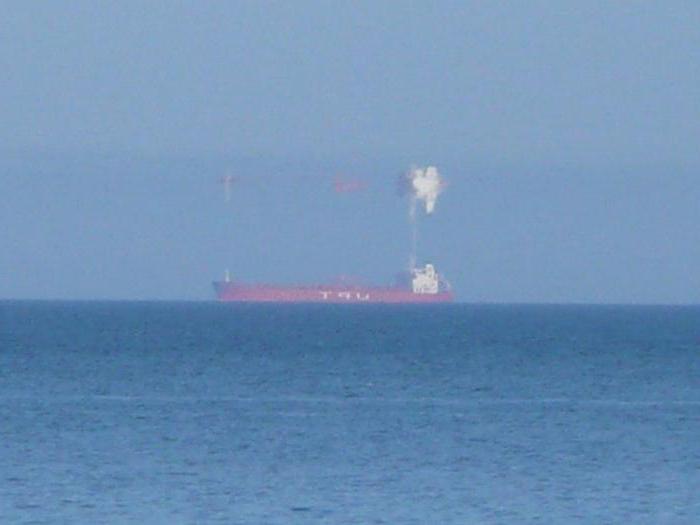
This type of mirage is usually observed in cold conditions, when the air temperature rises with increasing altitude, for example, in the polar regions on large, flat ice floes. This is quite rare in nature, and not even all eminent travelers who have visited the northern parts of our planet have seen this type of mirage. The meaning of this phenomenon is that if the bend of the sun's rays is exactly the same as the curve of the Earth's surface, then this makes it possible to see objects that are located beyond the horizon at a very large distance. There is a legend that the Vikings discovered Iceland thanks to him. So a mirage is sometimes a rather useful phenomenon. And perhaps this is the explanation for the myths about flying ships - such a mirage at sea makes them visible from the horizon and visually greatly increases both the size and speed of the ship.
Side
With side mirages everything is somewhat less exciting than with other types. They arise as a result of strong heating of vertical surfaces by the sun. For example, there is a documented fact when in the Middle Ages the wall of a fortress shone like a mirror, and outwardly it seemed that it had become partially invisible and ghostly. So now we know the meaning of the word mirage and have figured out what it is.
Volume mirage
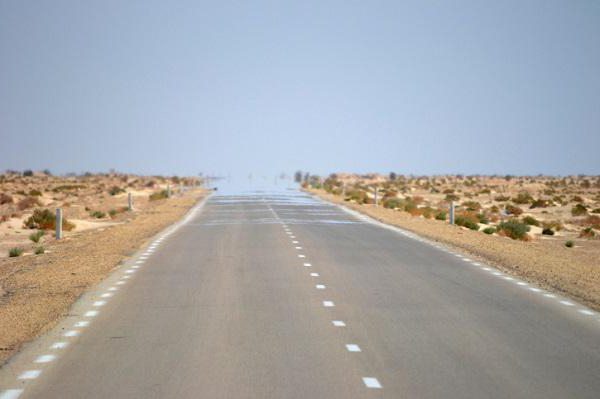
This type is also quite rare and mainly in the mountains. During this illusion, you can see yourself or other objects relatively nearby in a distorted perspective. This phenomenon is explained by the presence of water particles in the “stagnant” mountain air.
Culture

Mirage as a phenomenon is strongly reflected in culture - films, books, legends and fairy tales. Since ancient times, many travelers or explorers have been deceived by mirages by showing water where there is none. And by the way, if you walk on a hot day on a flat surface, for example, a road, then the lower mirage will move further and further as you approach it. One can only imagine the moral torment experienced by people who were stuck in the desert without a drop of water and saw such a deceptive phenomenon.
A mirage is an illusion of water; it is this form of it that is most common both in life and in culture of various kinds. But as we see, its varieties do not end there.
The ancient Egyptians believed that a mirage was the ghost of a country that no longer exists. Legend says that every place on Earth has its own soul. Mirages observed in deserts are explained by the fact that hot air acts like a mirror. This phenomenon is quite common - for example, about 160 thousand mirages are observed annually in the Sahara: they can be stable and wandering, vertical and horizontal.
On May 8, 2006, thousands of tourists and local residents observed a mirage that lasted for four hours in Penglai off the east coast of China on Sunday. The fogs created an image of the city, with modern high-rise buildings, wide city streets and noisy cars.
It rained for two days in the city of Penglai before this rare weather event occurred.
It is almost impossible to study mirages, since they do not appear on order and are always original and unpredictable. According to scientists, the atmosphere is like a layered, airy cake, which consists of layers with different temperatures. And the greater the temperature difference, the more the path of the light beam is bent. In this case, it is as if a giant airy lens is formed, which moves all the time. In addition, the observed object and the person himself are inside this air lens. Therefore, the observer sees the image distorted. The more complex the shape of the atmospheric lenses, the more bizarre the mirage.
Atmospheric mirages divided into three classes: lower or lake; upper(they appear directly in the sky) or distant vision mirages; lateral mirages.
A more complex type of mirage is called " Fata Morgana". No explanation has yet been found for it. The aurora borealis, werewolf mirages, and the “Flying Dutchmen” are usually classified as types of mirages.
Lower (lake) mirage
Inferior mirages are quite common. For example, water seen on desert sand or hot asphalt is a mirage of the sky above the hot sand or asphalt. Airplane landings in movies or car races on television are often filmed very close to the surface of hot asphalt. Then below the car or plane you can see their mirror image (inferior mirage), as well as the mirage of the sky. By the same principle, if you look at an object, for example, along a wall heated by the sun, then you can almost always see a mirage of the object next to the wall.
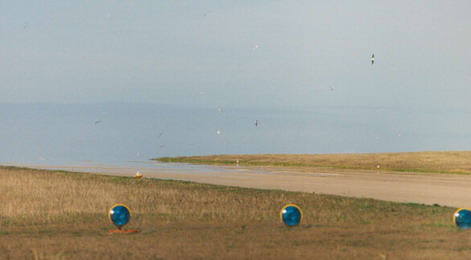
If on a hot summer day you stand on the railway track or a hill above it, when the sun is slightly to the side or to the side and slightly in front of the railway track, then you can see how the rails two or three kilometers away from us seem to be plunging into a sparkling lake, as if the tracks were flooded flood. Let's try to get closer to the "lake" - it will move away, and no matter how much we walk towards it, it will invariably be 2-3 kilometers away from us.
Such “lake” mirages drove desert travelers, languishing from heat and thirst, to despair. They also saw the coveted water 2-3 kilometers away, they wandered towards it with all their strength, but the water receded and then seemed to dissolve in the air.

In the photo, the sailboat almost disappears into the lower mirage. Only the sail is visible.

Lighthouse Isokari

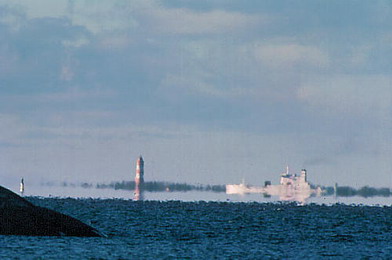
The lower mirage and the ship's mirage.
Superior mirages (distance vision mirages)
This type of mirages is no more complex in origin than “lake” ones, but more diverse. They are usually called "distant vision mirages".
On a clear morning, residents of the Côte d'Azur of France have seen more than once how, on the horizon of the Mediterranean Sea, where the water merges with the sky, the chain of Corsican mountains rises from the sea, about two hundred kilometers from the Côte d'Azur.
In the same case, if this happens in the desert itself, the surface of which and the adjacent layers of air are heated by the sun, the air pressure at the top may turn out to be high, the rays will begin to bend in the other direction. And then curious phenomena will occur with those rays that, having reflected from the object, should have immediately buried themselves in the ground. But no, they will turn upward and, having passed perigee somewhere near the surface itself, will go into it.
A typical example is given in Aristotle's Meteorology: residents of Syracuse sometimes saw the coast of continental Italy for several hours, although it was 150 km away. Such phenomena are also caused by the redistribution of warm and cold layers of air. in the direction of the last segment of the path of the light beam.
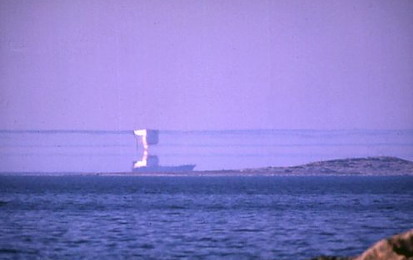
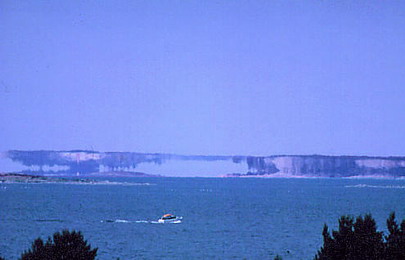
Boat against a background with a typical superior mirage
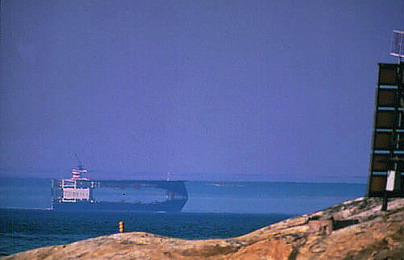
On April 20, 1999, an ordinary charterer was practicing in the waters of the southwestern archipelago of Finland.
The vessel took many different forms; sometimes it seemed there were 2 ships, one of which was upside down.
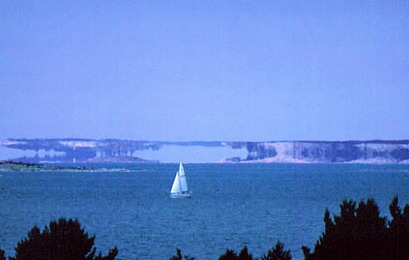
Superior mirage and sailboat.
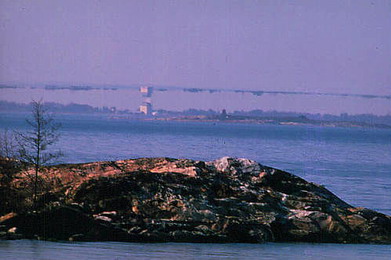
House on the archipelago with the upper mirage
Side mirages
This type of mirage can occur in cases where layers of air of the same density are located in the atmosphere not horizontally, as usual, but obliquely or even vertically. Such conditions are created in the summer, in the morning shortly after sunrise, on the rocky shores of the sea or lake, when the shore is already illuminated by the Sun, and the surface of the water and the air above it are still cold. Lateral mirages have been repeatedly observed on Lake Geneva. We saw a boat approaching the shore, and next to it exactly the same boat was moving away from the shore. A side mirage can appear near a stone wall of a house heated by the Sun, and even on the side of a heated stove.
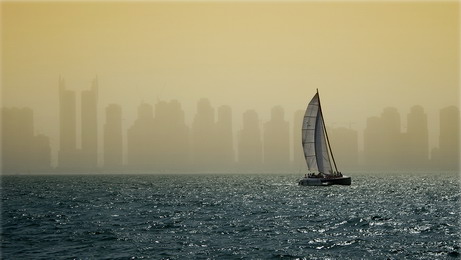
Fata Morgana
Fata Morgana is a complex optical phenomenon in the atmosphere, consisting of several forms of mirages, in which distant objects are visible repeatedly and with various distortions. Fata Morgana occurs when several alternating layers of air of varying densities are formed in the lower layers of the atmosphere, capable of producing specular reflections. As a result of reflection, as well as refraction of rays, real-life objects produce several distorted images on the horizon or above it, partially overlapping each other and quickly changing in time, which creates a bizarre picture of Fata Morgana.
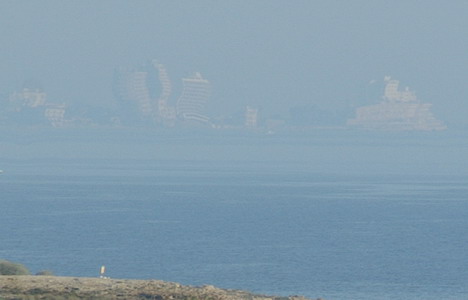
The mirage received its name in honor of the fairy-tale heroine Fata Morgana or, translated from Italian, the fairy Morgana. They say that she is the half-sister of King Arthur, the rejected lover of Lancelot, who settled out of grief at the bottom of the sea, in a crystal palace, and since then has been deceiving sailors with ghostly visions.
On April 3, 1900, the defenders of the fortress of Bloemfontein, in England, saw the battle formations of the British army in the sky, and so clearly that they could distinguish the buttons on the red uniforms of the officers. This was taken as a bad omen. Two days later the fortress surrendered.
In 1902, Robert Wood, an American scientist who not without reason earned the nickname “the wizard of the physics laboratory,” photographed two boys peacefully wandering through the waters of the Chesapeake Bay between yachts. Moreover, the height of the boys in the photograph exceeded 3 meters.
One man in 1852, from a distance of 4 km, saw the Strasbourg Bell Tower at a distance, as it seemed to him, of two kilometers. The image was gigantic, as if the bell tower appeared before him enlarged 20 times.
TO Fata Morgana can be attributed to numerous " flying dutchmen ", which are still seen by sailors.
At 11 a.m. on December 10, 1941, the team of the British transport Vendor, located in the area Maldives, noticed a burning ship on the horizon. "Vendor" went to the rescue of those in distress, but an hour later the burning ship fell on its side and sank. "Vendor" approached the supposed place of the ship's death, but, despite a thorough search, did not find not only any debris, but even stains of fuel oil. At the port of destination, in India, the commander of the Vendor learned that at the very moment when his team observed the tragedy, a cruiser was sinking, attacked by Japanese torpedo bombers near Ceylon. The distance between the ships at that time was 900 km.
Mirage ghosts
A French colonial detachment was crossing the Algerian desert. Ahead, about six kilometers from him, a flock of flamingos walked in single file. But when the birds crossed the border of the mirage, their legs stretched out and separated, instead of two, each had four. Neither give nor take - an Arab horseman in a white robe.
The detachment commander, alarmed, sent a scout to check what kind of people were in the desert. When the soldier himself entered the zone of curvature of the sun's rays, he, of course, figured out who he was dealing with. But he also struck fear into his comrades - the legs of his horse became so long that it seemed that he was sitting on a fantastic monster.
Other visions still baffle us today. The Swedish polar explorer Nordenskiöld has repeatedly observed in the Arctic werewolf mirages:
"One day, a bear, whose approach was expected and which everyone clearly saw, instead of approaching with his usual soft gait, zigzags and sniffing the air, wondering whether foreigners were suitable for him as food, just at the moment of the sniper's sight... spread gigantic wings and flew away in the form of a small green seagull. Another time, during the same sleigh ride, the hunters, being in a tent pitched for rest, heard the cry of a cook fiddling around it: “Bear, A big bear! No, it’s a deer, a very small deer.” At the same moment, a shot rang out from the tent, and the killed “bear-deer” turned out to be a small arctic fox, who paid with his life for the honor of pretending to be a large animal for a few moments".
It is also reliably known about mirages-ghosts. This is how British meteorologist Caroline Botley describes this effect.
Mirages lead to victims, but the physical explanation of the phenomenon of mirages does not in the least alleviate the fate of travelers misled by the ephemeral oasis. In order to protect people brought into the desert from the risk of getting lost and dying of thirst, special maps are drawn up marking the places where mirages are usually observed. These guides indicate where wells can be seen, and where palm groves and even mountain ranges can be seen.
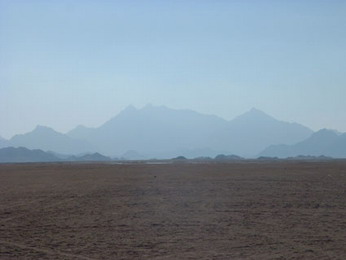
Caravans in the Erg-er-Ravi desert in North Africa are especially often victims of mirages. People see oases “with their own eyes” at a distance of 2-3 kilometers, which are actually at least 700 kilometers.
